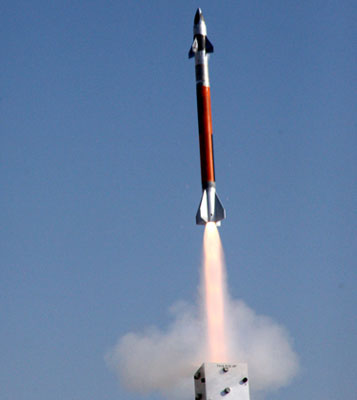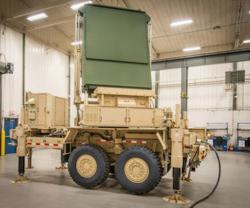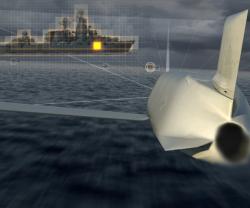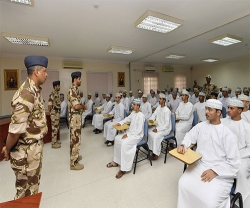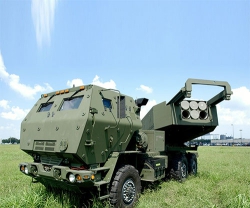LM's EAPS Conducts Miniature Hit-To-Kill Interceptor Test
26.03.2013 North America
Lockheed Martin’s Extended Area Protection and Survivability (EAPS) program successfully conducted the first Guided Test Flight to characterize the seeker, guidance, navigation and control systems of its Miniature Hit-to-Kill (MHTK) interceptor.
The very small and agile interceptor is designed to defeat Rocket, Artillery and Mortar (RAM) targets at ranges greatly exceeding those of current systems.
The test was conducted on March 22 at White Sands Missile Range, New Mexico, in collaboration with the U.S. Army Research Development & Engineering Command/Aviation Missile Research Development & Engineering Center (RDECOM/AMRDEC). This test is another milestone in a series of technically challenging events completed under the EAPS Integrated Demonstration Science and Technology program.
The test closely replicated a tactical situation in which an enemy launches a mortar at an area protected by the MHTK intercept system. A radar successfully detected and tracked the threat in flight. The tactically configured MHTK interceptor launched vertically and flew a trajectory positioning it to detect energy from a ground illuminator reflected off the mortar target. Responding to the reflected energy, the MHTK interceptor maneuvered to fly very close to the target and gather data through its seeker as it passed the mortar in flight. Intercepting the target was not an objective of this flight test.
In addition to gathering data to characterize the interceptor’s performance, this test integrated and exercised the entire intercept system for the first time. The data collected will support an intercept flight test planned for later this year.
Loretta Painter, AMRDEC EAPS Program Director, said, “This guided flight represents progress for the program. The data collected is an important step toward our goal of providing improved indirect fire protection capability. We are very pleased with the initial review of the test data and this data will be extremely valuable in reducing risks and making necessary improvements prior to the next flight.”
“We continue to successfully demonstrate the MHTK intercept capability with our EAPS solution. We are confident the system will play a crucial role in the affordable and effective protection of our forces in the future,” said Mike Trotsky, Vice President of Air & Missile Defense at Lockheed Martin Missiles and Fire Control.
The Lockheed Martin MHTK interceptor is on track to meet the AMRDEC Average Unit Production Cost goal of $16,000 per interceptor in 2006 dollars at specified quantities, making it much more affordable than systems it will replace. At less than 1 meter long, less than 50 millimeters in diameter and less than 3 kilograms mass at launch, the MHTK is extremely compact and very agile in flight. Paired with a fire control sensor capable of providing illumination, the MHTK provides robust defeat of RAM targets through body-to-body impact at tactically significant ranges, greatly increasing the protected volume in which our soldiers operate and offering commanders more flexibility than legacy and interim systems.
Lockheed Martin Missiles and Fire Control is a 2012 recipient of the U.S. Department of Commerce’s Malcolm Baldrige National Quality Award for performance excellence. The Malcolm Baldrige Award represents the highest honor that can be awarded to American companies for their achievements in leadership, strategic planning, customer relations, measurement, analysis, workforce excellence, operations and results.
The very small and agile interceptor is designed to defeat Rocket, Artillery and Mortar (RAM) targets at ranges greatly exceeding those of current systems.
The test was conducted on March 22 at White Sands Missile Range, New Mexico, in collaboration with the U.S. Army Research Development & Engineering Command/Aviation Missile Research Development & Engineering Center (RDECOM/AMRDEC). This test is another milestone in a series of technically challenging events completed under the EAPS Integrated Demonstration Science and Technology program.
The test closely replicated a tactical situation in which an enemy launches a mortar at an area protected by the MHTK intercept system. A radar successfully detected and tracked the threat in flight. The tactically configured MHTK interceptor launched vertically and flew a trajectory positioning it to detect energy from a ground illuminator reflected off the mortar target. Responding to the reflected energy, the MHTK interceptor maneuvered to fly very close to the target and gather data through its seeker as it passed the mortar in flight. Intercepting the target was not an objective of this flight test.
In addition to gathering data to characterize the interceptor’s performance, this test integrated and exercised the entire intercept system for the first time. The data collected will support an intercept flight test planned for later this year.
Loretta Painter, AMRDEC EAPS Program Director, said, “This guided flight represents progress for the program. The data collected is an important step toward our goal of providing improved indirect fire protection capability. We are very pleased with the initial review of the test data and this data will be extremely valuable in reducing risks and making necessary improvements prior to the next flight.”
“We continue to successfully demonstrate the MHTK intercept capability with our EAPS solution. We are confident the system will play a crucial role in the affordable and effective protection of our forces in the future,” said Mike Trotsky, Vice President of Air & Missile Defense at Lockheed Martin Missiles and Fire Control.
The Lockheed Martin MHTK interceptor is on track to meet the AMRDEC Average Unit Production Cost goal of $16,000 per interceptor in 2006 dollars at specified quantities, making it much more affordable than systems it will replace. At less than 1 meter long, less than 50 millimeters in diameter and less than 3 kilograms mass at launch, the MHTK is extremely compact and very agile in flight. Paired with a fire control sensor capable of providing illumination, the MHTK provides robust defeat of RAM targets through body-to-body impact at tactically significant ranges, greatly increasing the protected volume in which our soldiers operate and offering commanders more flexibility than legacy and interim systems.
Lockheed Martin Missiles and Fire Control is a 2012 recipient of the U.S. Department of Commerce’s Malcolm Baldrige National Quality Award for performance excellence. The Malcolm Baldrige Award represents the highest honor that can be awarded to American companies for their achievements in leadership, strategic planning, customer relations, measurement, analysis, workforce excellence, operations and results.
Latest news
Latest events
DSEI 2025
09 - 12 Sep 2025Excel, London - United KingdomIntersec Saudi Arabia
29 Sep - 01 Oct 2025Riyadh International Exhibition & Convention Centre - Saudi ArabiaDubai International Air Chiefs’ Conference (DIACC 2025)
16 Nov 2025Atlantis, The Palm Dubai - United Arab EmiratesDubai Airshow
17 - 21 Nov 2025Dubai World Central (DWC) - United Arab Emirates

